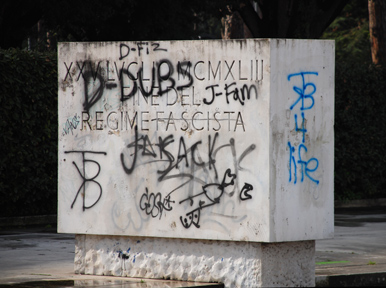5th Army Rest Center in Rome
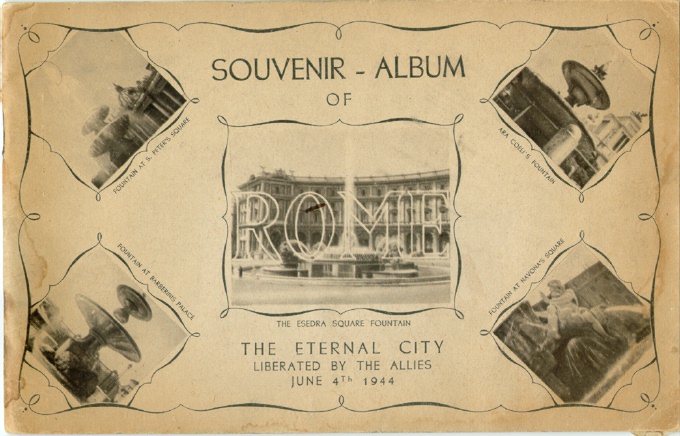 |
<= Souvenir Album with photos of Rome printed on nice glossy paper. Card stock cover with good quality photo paper. Size: 6 X 9-1/2 inch Meal Pass for Rome dated July 29, 1944 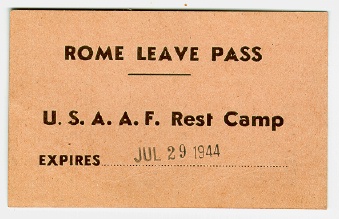 |
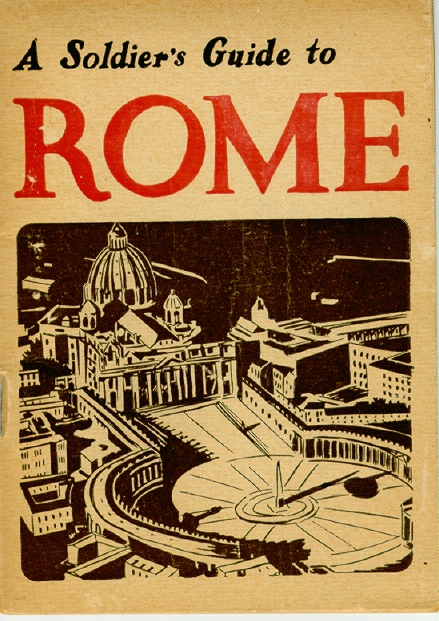 |
A Guide Booklet to Rome History and photos of Rome. Fold-out Map of the city. Useful Italian words and phrases. Newsprint paper Size: 4-3/4 X 6-3/4 inch |
Return to Main Menu
Foro Mussolini - Mussolini Forum
In modern times it is called Foro Italico and was the site of a summer Olympic games.
View of Front Gate of the Rest Center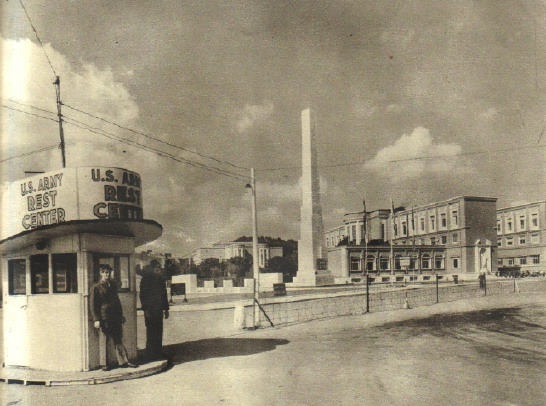 |
Recent photo of Obelisk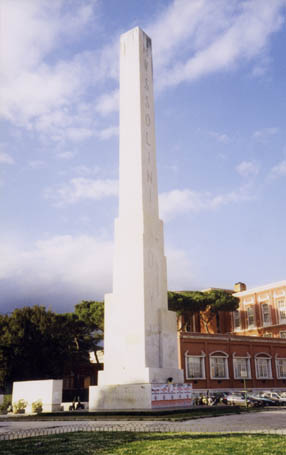 |
| Obelisk inscribed
"Mussolini
Dux" is 17m high without the base, and
36m high with the base and the point. Blocks surround the piazza
that commorates the Fall of Ethiopia and
other events during Mussolini's reign. |
| Aerial photo of the
Rest Center taken during WW2 The Rest Center
complex was located across the Tiber River from Rome. One stadium is
encircled by marble
statues. Note the Obelisk
located at the end of the bridge.
|
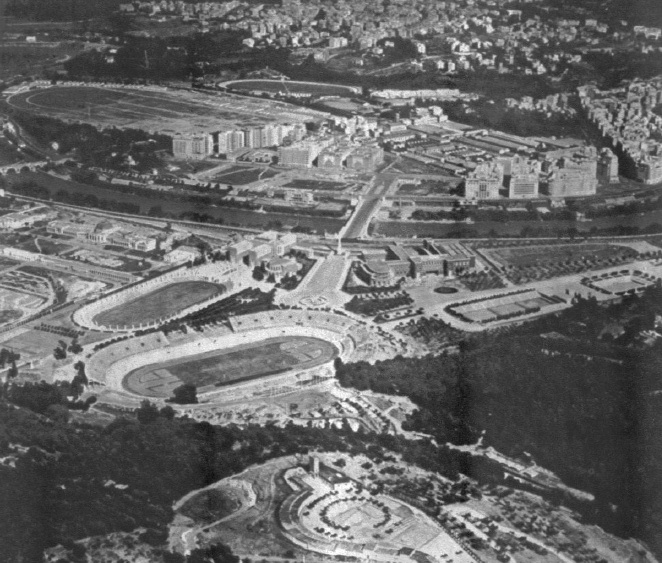 |
|
Statues surrounding one of the Arenas. |
Paintings on the walls of the Pool |
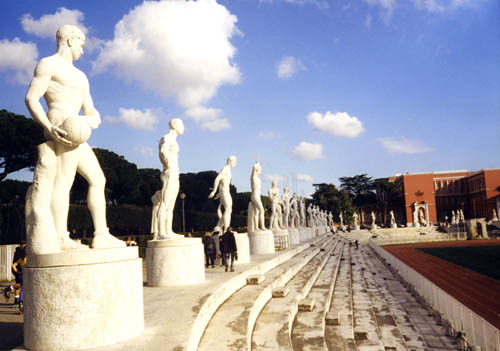 |
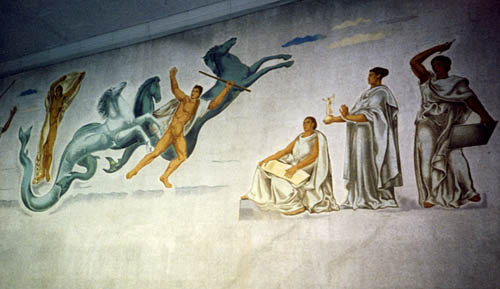 Used
by permission of Professor Moore, UTA.
|
| More Photos of the
Piazza at Foro Mussolini Mural of
Soliders giving the Fascist salute to Il Duce, Our Leader.
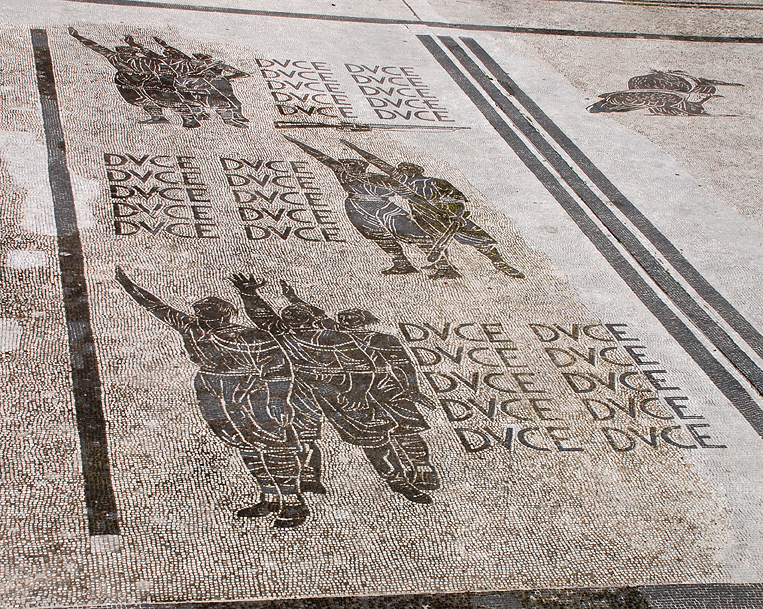 |
Piazza - Mural of Airplanes and Troops. Ancient Roman blessing the flag of the modern soldier. 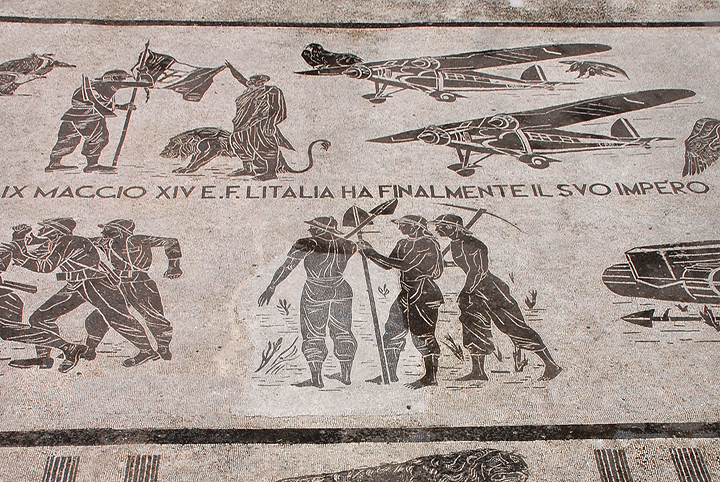 |
|
Photos used by permission of James Hull |
Return to Main Menu Return to top of Foro Mussolini
Caserta Center
As the Allies advanced north of Naples, the city was captured by the British 56th Infantry Regiment on 3 October 1943.
Caserta was the scene of the signing of the German surrender on 29 April, 1945.
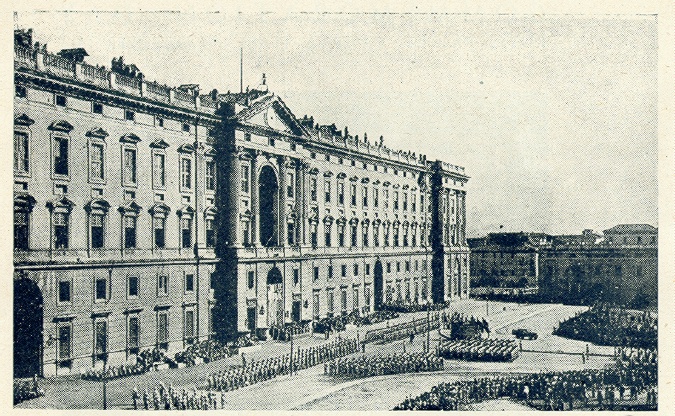 Allied troops parade in front of the Royal Place in Caserta on Commemoration Day. Photo
from an Army brochure published on 1946 anniversary of its liberation.
|
| The Palace was
used for scenes in two Star
Wars movies and Mission
Impossible III. |
Return to Main Menu
Montecatini Rest Center
A veteran of the 85th Division described his time there as a place with a USO Club or Red Cross Club that included music, dancing and some Italian gals, maybe a few Red Cross girls - coffee, etc.
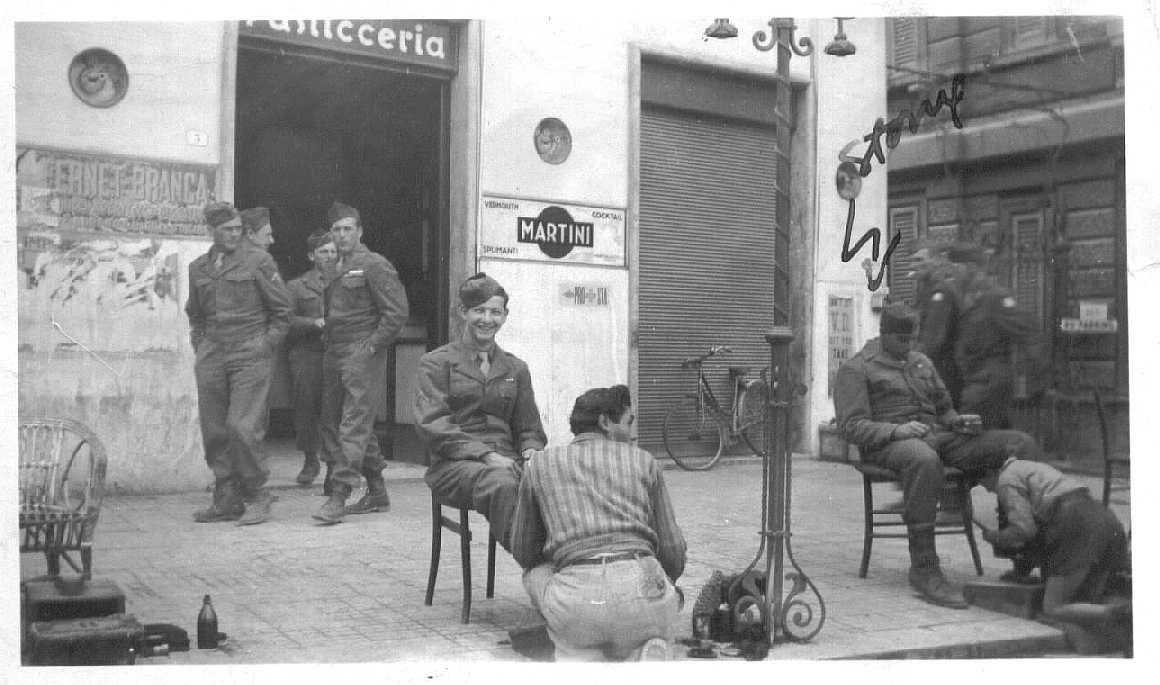 American soldiers enjoying the shops at Montecatini. The GI's are wearing the short "Ike" jacket with all their ribbons and patches. |
|
The 337th Infantry Regiment, 85th Infantry Division was sent to
Montecatini on 13 March, 1945 for a 4-day period of rest and retraining before the Spring Offensive that ended the war. |
Return to Main Menu Return to top of Montecatini
Florence Rest Center
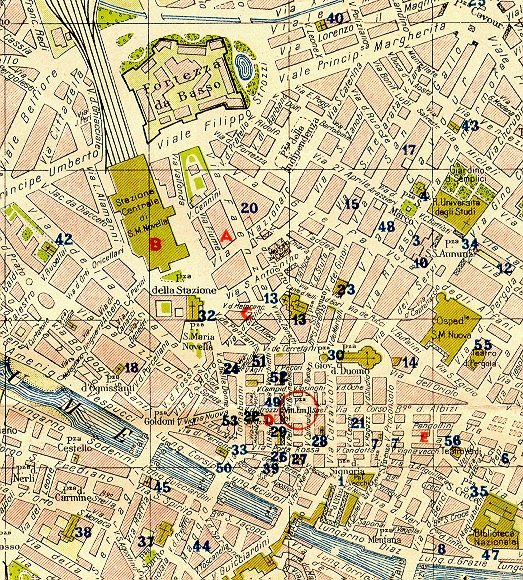
|
Red Cross Fold-out Map & Brochure This Red Cross Brochure was given to the soldiers during their visit to Florence. On the back of the map, the seven panels of the foldout has sketches of some of the attractions. The colored Map have the tourists sites of Florence marked with numbered index. For example, #30 is the famous domed church San Giovanni Duomo. Letters
denote locations for soldiers:
A Red Cross
Apollo Theater
B 5th Army Rest Camp, at R.R. Station C Red Cross Regional Office D Red Cross Enlisted Mens Bath House E Red Cross Officers Club Large Circle Red Cross Enlisted Mens Club and Snack Bar (This is not the rest
center known as Montecaniti
Rest Area,
which was to the northwest of Florence.) |
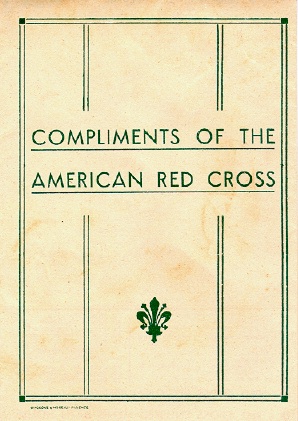 |
Cover of the Red Cross Map The maps folds up into a pocket-size Brochure. The other 7 panels on the reverse side of the Map have ink sketches of the tourist sites. Size: Folded = 4-1/4 X 6-1/4 inches Unfolded= 12-1/4 X 16-1/2 inches 2 variations of map markings were printed. |
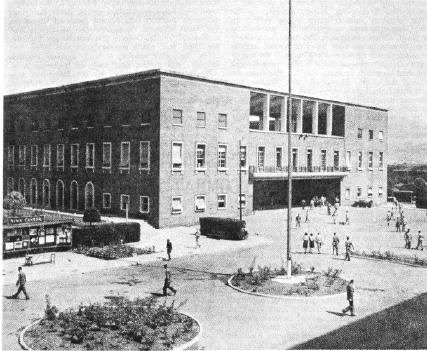 Florence University was set-up after the war ended to train soldiers in a skill they would apply to their civilian job. Photo from "Attack! Attack! Attack!" by Battery Press |
A University Training Center was established at My father was a colllege graduate in agriculture. He said he taught classes to the soldiers but it is not known if he taught at the university in Florence or not. |
Return to Main Menu Return to top of Florence Rest Center
"Dairy Farm" - Volturno Redeployment Training Area
"Repple-Depple" was a GI term for Replacement Depot. These were centers for replacement troops to arrive and get assigned to their units. I've included in this list as many soldiers passed through this area and many say they spent their last days here before shipping out of Naples port to their homes.
Another rest center was Lido di Roma (The King's Forest) southeast of Rome, which was used as a rest and refitting area for Fifth Army units just out of combat. From there, the GI's could visit Rome and stay in any of the Fifth Army designated rest centers in the city. 85th Division was located there in June 1944
Return to Main Menu Return to top of Florence Rest Center
Gagliano Winter Quarters - Winter rest and re-training
A description from "History of the 85th Division in World War II".
"Galliano was a small town serviced by dirt roads which had now turned to slippery, sticky mud. Just outside of the main part of the town and a little way up the hillside were several large individual houses. They could not be called villas, but they were luxurious compared with the living accommodations afforded in town. Several of the houses had large stone barns which troops found suitable for a temporary residence. At least they were better than a pup tent or a pyramidal tent. Housing was inadequate, of course, and many of the men found themselves setting up in pyramidal tents. There wasn't much to Galliano but somehow, like many other places where the Division stopped for more than a week, it seemed like home. No doubt the contrast with the unbearable conditions endured during combat made Galliano more pleasant than it would otherwise have appeared. "
Return to Main Menu
Quotes
|
Quotes about the GI's experience at Rest Camps
This
letter was
written at the rest camp at 29 April 1944 “We slept in buildings, the mess hall was a huge room, there were showers and Red Cross rooms and more movies then a guy could care to see... it gave me a carefree feeling to walk up and down streets watching the people... so now it's over and I am back..” 6 November 1944 "The very first day of November 1944 we were relieved but could not move off our position that night. At dawn's light we rode in trucks in pouring rain for hours to Montecatini, a health resort. We were put up in a large building, enjoyed hot showers, clean uniforms and a hot meal which was our first since before From the memoirs of George Avery, Co A, 84th Chemical
Mortar Bn |
|
|
“I arrived in Paul D. Hinkle - Company L, 141st
Infantry Regiment, 36th Division
|
| "On Thursday, 23 November
1944,
Charlie Battery went
to the new Fifth Army Rest Center at Montecatini to
enjoy
a well earned rest. They returned to the Battalion bivouac area
on
the 28th. On the same day Baker Battery left for Montecatini,
followed
by Able, Service and Headquarters on the 29th. The new style Rest
Center was a famous "Spa", patronized by wealthy Italians and
tourists
before the war. The men were quartered in hotels, and except for
a hike each morning, and two hours of section training each afternoon,
they had free run of the town from three in the afternoon until ten
o'clock
at night. There were bars, movies, USO shows, and baths - both of
the G.I. and civilian variety, and the Battalion made the most of its
opportunities.
The end of November found the 328th still in the rest areas, and
enjoying
a very high morale." Excerpt from Operational Report
of 328 Field Artillery Battalion, 85th Infantry Division
Dated 16 December 1944. |
|
|
U.S.
Troops leave a Ticking Time Bomb
During World War II, soldiers from the 5th US Army set up camp at an exclusive hunting estate in Italy. Sixty years later, forest pathologists are pointing to huge gaps of dead trees in the estate as the visible reminders of that brief stay. In a new study published in the April issue of Mycological Research, researchers at the University of California, Berckeley, and in Italy, have unlocked the mystery of how the destructive Heterobasidion annosum pathogen could have spread to the Presidential Estate of Castelporziano, which has been sealed off from the public for centuries. They were able to trace the origins of the pathogen back to eastern North America, where US troops departed for Europe during WW2. The researchers say the pathogen likely hitched a ride in transport crates, pallets or other military equipment made from untreated lumber from infected trees. It took decades for the pathogen to establish itself, but since symptoms were first noticed in the 1980's, the root fungus has wiped out large swaths of stone pine trees in the Castelporziano estate less than 15 miles southwest of Rome. UC Berkeley Press Release,
dated 30 March 2004
|
Special Thanks to Professor Moore of University of Texas at Austin for permission for the use his photos.
Special Thanks to James Hull for permission to use his photos of Foro Mussolini.
Link:
http://ccwf.cc.utexas.edu/~tjmoore/imagesofrome/Mussolini/index.htm
Other Link:
http://www.hist.uib.no/antikk/eftertid/foroitalicoL.htm
http://www.jameshull.com/foroitalico.html
Return to Main Menu
